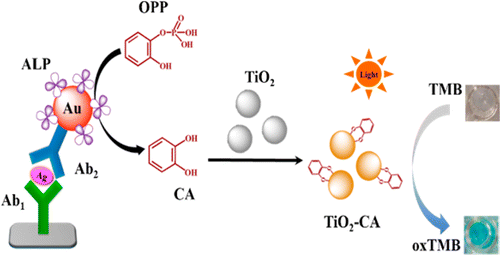当前位置:
X-MOL 学术
›
Anal. Chem.
›
论文详情
Our official English website, www.x-mol.net, welcomes your
feedback! (Note: you will need to create a separate account there.)
Versatile and Amplified Biosensing through Enzymatic Cascade Reaction by Coupling Alkaline Phosphatase in Situ Generation of Photoresponsive Nanozyme
Analytical Chemistry ( IF 6.7 ) Pub Date : 2015-10-06 00:00:00 , DOI: 10.1021/acs.analchem.5b02728 Lu-Yi Jin 1 , Yu-Ming Dong 1 , Xiu-Ming Wu 1 , Gen-Xia Cao 1 , Guang-Li Wang 1, 2
Analytical Chemistry ( IF 6.7 ) Pub Date : 2015-10-06 00:00:00 , DOI: 10.1021/acs.analchem.5b02728 Lu-Yi Jin 1 , Yu-Ming Dong 1 , Xiu-Ming Wu 1 , Gen-Xia Cao 1 , Guang-Li Wang 1, 2
Affiliation

|
The alkaline phosphatase (ALP) biocatalysis followed by the in situ enzymatic generation of a visible light responsive nanozyme is coupled to elucidate a novel amplification strategy by enzymatic cascade reaction for versatile biosensing. The enzymatic hydrolysis of o-phosphonoxyphenol (OPP) to catechol (CA) by ALP is allowed to coordinate on the surface of TiO2 nanoparticles (NPs) due to the specificity and high affinity of enediol ligands to Ti(IV). Upon the stimuli by CA generated from ALP, the inert TiO2 NPs is activated, which demonstrates highly efficient oxidase mimicking activity for catalyzing the oxidation of the typical substrate of 3,3′,5,5′-tetramethylbenzidine (TMB) under visible light (λ ≥ 400 nm) irradiation utilizing dissolved oxygen as an electron acceptor. On the basis of the cascade reaction of ALP and the nanozyme of CA coordinated TiO2 (TiO2–CA) NPs, we design exquisitely colorimetric biosensors for probing ALP activity and its inhibitor of 2, 4-dichlorophenoxyacetic acid (2,4-DA). Quantitative probing of ALP activity in a wide linear range from 0.01 to 150 U/L with the detection limit of 0.002 U/L is realized, which endows the methodology with sufficiently high sensitivity for potentially practical applications in real samples of human serum (ALP level of 40–190 U/L for adults). In addition, a novel immunoassay protocol by taking mouse IgG as an example is validated using the ALP/nanozyme cascade amplification reaction as the signal transducer. A low detection limit of 2.0 pg/mL is attained for mouse IgG, which is 4500-fold lower than that of the standard enzyme-linked immuno-sorbent assay (ELISA) kit. Although only mouse IgG is used as a proof-of-concept in our experiment, we believe that this approach is generalizable to be readily extended to other ELISA systems. This methodology opens a new horizon for amplified and versatile biosensing including probing ALP activity and following ALP-based ELISA immunoassays.
中文翻译:

通用和放大生物传感通过酶促级联反应由耦合碱性磷酸酶原位光响应Nanozyme的代
碱性磷酸酶(ALP)生物催化,然后原位酶促生成可见光响应纳米酶,通过酶联级联反应阐明了一种新颖的扩增策略,从而实现了广泛的生物传感。由于烯二醇配体对Ti(IV)的特异性和高亲和力,允许通过ALP将邻膦酰氧基苯酚(OPP)酶解为邻苯二酚(CA),从而在TiO 2纳米颗粒(NPs)的表面上进行配位。在ALP产生的CA刺激下,惰性TiO 2NPs被激活,显示出高效的氧化酶模拟活性,可利用溶解氧作为电子,在可见光(λ≥400 nm)辐照下催化3,3',5,5'-四甲基联苯胺(TMB)的典型底物的氧化受体。基于ALP和CA配位的TiO 2(TiO 2)的纳米酶的级联反应–CA)NP,我们设计了用于检测ALP活性及其2、4-二氯苯氧基乙酸(2,4-DA)抑制剂的精美比色生物传感器。实现了在0.01至150 U / L的宽线性范围内,检测限为0.002 U / L的ALP活性的定量检测,这为该方法提供了足够高的灵敏度,可用于实际人血清样品中的实际应用(ALP水平成人的价格为40–190 U / L)。此外,使用ALP /纳米酶级联扩增反应作为信号转导剂,验证了以小鼠IgG为例的新型免疫测定方案。小鼠IgG的检测限低至2.0 pg / mL,比标准酶联免疫吸附测定(ELISA)试剂盒的检测限低4500倍。尽管在我们的实验中仅将小鼠IgG用作概念验证,我们认为这种方法可以推广到其他ELISA系统。该方法为扩增和通用的生物传感开辟了新的前景,包括探测ALP活性和基于ALP的ELISA免疫测定。
更新日期:2015-10-06
中文翻译:

通用和放大生物传感通过酶促级联反应由耦合碱性磷酸酶原位光响应Nanozyme的代
碱性磷酸酶(ALP)生物催化,然后原位酶促生成可见光响应纳米酶,通过酶联级联反应阐明了一种新颖的扩增策略,从而实现了广泛的生物传感。由于烯二醇配体对Ti(IV)的特异性和高亲和力,允许通过ALP将邻膦酰氧基苯酚(OPP)酶解为邻苯二酚(CA),从而在TiO 2纳米颗粒(NPs)的表面上进行配位。在ALP产生的CA刺激下,惰性TiO 2NPs被激活,显示出高效的氧化酶模拟活性,可利用溶解氧作为电子,在可见光(λ≥400 nm)辐照下催化3,3',5,5'-四甲基联苯胺(TMB)的典型底物的氧化受体。基于ALP和CA配位的TiO 2(TiO 2)的纳米酶的级联反应–CA)NP,我们设计了用于检测ALP活性及其2、4-二氯苯氧基乙酸(2,4-DA)抑制剂的精美比色生物传感器。实现了在0.01至150 U / L的宽线性范围内,检测限为0.002 U / L的ALP活性的定量检测,这为该方法提供了足够高的灵敏度,可用于实际人血清样品中的实际应用(ALP水平成人的价格为40–190 U / L)。此外,使用ALP /纳米酶级联扩增反应作为信号转导剂,验证了以小鼠IgG为例的新型免疫测定方案。小鼠IgG的检测限低至2.0 pg / mL,比标准酶联免疫吸附测定(ELISA)试剂盒的检测限低4500倍。尽管在我们的实验中仅将小鼠IgG用作概念验证,我们认为这种方法可以推广到其他ELISA系统。该方法为扩增和通用的生物传感开辟了新的前景,包括探测ALP活性和基于ALP的ELISA免疫测定。































 京公网安备 11010802027423号
京公网安备 11010802027423号